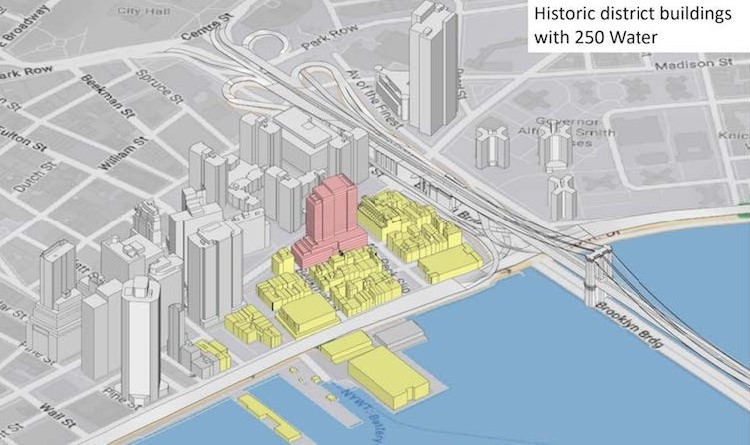BY THE VILLAGE SUN | The South Street Seaport Coalition is desperately trying to keep fighting the 250 Water St. tower project by Howard Hughes Corporation that they say is wildly inappropriate for the low-scale South Street Seaport Historic District.
On June 29, the coalition filed a “motion to reargue and leave to appeal” the latest ruling in the case, which came down last month, when the New York State Appellate Court reversed the verdict of a lower court, at State Supreme Court, which in January had found for the plaintiffs.
It will now be up to the state’s highest court, the Court of Appeals, to decide if they will hear the case.
The lawsuit — South Street Seaport Coalition and four local residents versus the city’s Landmarks Preservation Commission — argues L.P.C. was wrong to green-light the development project, and that Landmarks should never have considered any funding that the South Street Seaport Museum would get as a contingency to the project. The construction project is slated for a parking lot that is bordered by a number of schools for young children and residential complexes.
In a press release, the coalition stresses of its litigation, “There is a long-standing public interest in upholding the integrity of the L.P.C. and the efficacy of the Landmarks Law.”
More to the point, the plaintiffs say unearthed e-mails prove there has been an unseemly “direct coordination” between City Hall and the developer to push the project through — leaving the process “tainted.”
“Seaport Coalition volunteers combed through 3,000 de Blasio administration e-mails and found there was direct coordination between the administration, the L.P.C. and the developer, the Howard Hughes Corporation (HHC),” the press release charges. “We proved in the lower court that HHC spent untold millions of dollars on lawyers and lobbyists to craft a strategy to taint or corrupt the L.P.C. process and obtain a predetermined result. In fact, HHC corresponded, spoke to, or met with L.P.C. an unheard of 50 times or more over the course of its application for 250 Water St. It also met with representatives from the de Blasio administration about the proposal an unheard of 40 times or more.
“Particularly concerning,” the press release continues, “was a ‘practice hearing,’ in which HHC and L.P.C. senior staff rehearsed to coordinate their presentation to the commissioners together, one week before the actual public hearing.
“HHC’s scheme was to promote funding for the cash-strapped Seaport Museum in a quid pro quo arrangement for the approval of their proposal, spelled out as ‘political cover’ in an HHC internal document,” the coalition charges.
The Seaport Coalition further accuses the New York City Economic Development Corporation of being “a complicit actor” after receiving money from HHC from a purchase of air rights (development rights).
The coalition charges, “NYCEDC kept the $40 million proceeds of the air rights sale out of the city’s general fund and the normal budgetary process to create a yearly $2 million operating allowance doled out, with strings attached, for the museum — hardly a $40 million charitable donation as touted by HHC publicists.
“It is expressly stated in Landmarks Law,” the coalition press release states, “that L.P.C. may only rule upon design, without considering community benefits. Nevertheless, to keep this prearrangement upmost in mind, L.P.C. Chairperson Sarah Carroll allowed an HHC design for an imaginary museum annex building to be considered concurrently with 250 Water St. Such close coordination with HHC undermines the impartiality of L.P.C., without which it cannot fulfill its responsibility to safeguard our historic districts. It also erodes public trust in a rules-based government.”
The Seaport Coalition lawsuit is being carefully followed by other groups fighting City Hall on land-use issues, particularly those affecting landmarked historic districts.
“Recent battles over the Chinatown jail, [rezonings for] Inwood and Soho/Noho and now the Seaport, have been stymied by lame-duck politicians and mayoral agencies,” the plaintiffs argue. “Hours of public testimony are dismissed as merely ‘advisory,’ a perfunctory duty, absent meaningful engagement. Instead, community boards, grassroots organizations and volunteers must resort to the legal system, with everyday citizens devoting scarce time and resources to battle Big Real Estate. This new normal enables developers to engage in backroom dealings, with City Hall counting on the courts to look the other way.
“The case of the South Street Seaport Coalition, Inc. v LPC continues,” the coalition vows in their statement. “Anything else would be an affront to the Seaport and the other 159 cherished New York City Historic Districts.”
In response to the Seaport Coalition’s appeal, a spokesperson for the Howard Hughes Corporation issued a brief statement, saying, “We remain confident that, as the Appellate Division unanimously recognized, the Landmarks Preservation Commission’s approval of our project was proper and made in full compliance with the Landmarks Law.”


Be First to Comment